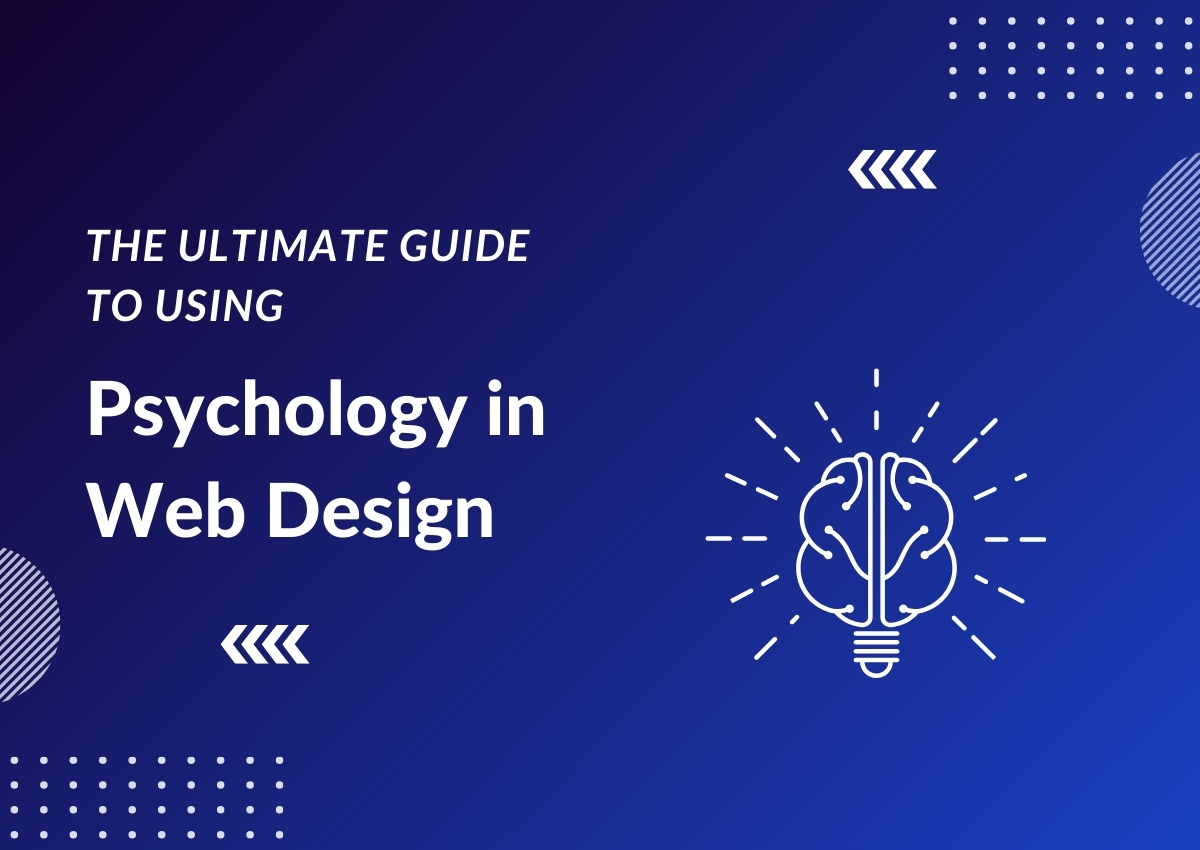The Ultimate Guide to Using Psychology in Web Design

In the vast realm of the internet, websites are constantly competing for people’s attention.
Therefore, to stand out from the crowd, web design must go beyond just aesthetics.
Behind every visual aspect lies a psychological principle that influences human behavior and decision-making.
By understanding these principles, you can create websites that not only look appealing but also cater to the needs and desires of your target audience.
So, in this article, we’re going to explore the use of psychology in web design and how you can implement it to impact user experience.
What Is Web Design Psychology?
Web design psychology is the utilization of psychological principles and techniques in website design to enhance user experience, engagement, and conversion rates.
It involves understanding how users think, feel, and behave when interacting with a website. And using this knowledge to create a design that appeals to them on a deeper level.
Why Use Psychology in Web Design?
In today’s digital age, having a visually appealing website is not enough to stand out from the competition.
Websites that successfully incorporate psychological elements, can create a more meaningful and memorable experience for users.
By tapping into human psychology, web designers can design websites that grab attention, keep users engaged, and ultimately drive them toward desired actions.
Advantages of Using Web Design Psychology
1. Improved User Experience: By understanding how users think, feel, and behave on a website, designers can create an intuitive and user-friendly interface that makes navigation and interaction seamless. This leads to a more positive experience for users.
2. Increased Engagement: Incorporating elements such as gamification, personalization, and social proof can increase user engagement on a website. This can result in longer sessions, higher click-through rates, and a greater likelihood of conversions.
3. Building Trust: Incorporating psychological elements such as using familiar colors and images, creating a sense of familiarity and authenticity, can build trust with users. This can lead to an increased likelihood of them returning to the website or making a purchase.
4. Boosted Conversions: By understanding user behavior and using persuasive design techniques, web designers can create websites that influence user actions and decisions and drive more conversions and sales.
5. Creating an Emotional Connection: Using psychology in web design can tap into the emotions of users, creating a powerful and lasting connection with them. This can lead to increased brand loyalty and advocacy.
Incorporating Web Design Psychology Principles on Your Site
The Von Restorff Effect
This principle states that people are more likely to remember something that stands out from the rest.
Utilize this by adding contrasting colors, bold fonts, and eye-catching images on your website to make important information stand out.
Fitts’s Law
This law says that the time required to move a cursor to a target area is directly proportional to the distance and inversely proportional to the size of the target.
Design your website with this in mind, making important links and buttons larger and easier to click.
Gestalt Psychology
Gestalt psychology emphasizes the idea that humans perceive things as a whole rather than individual parts. Use this principle by creating simple and organized layouts that are visually pleasing to users.
Visual Hierarchy
This principle suggests that users tend to view elements in a specific order, with larger and more visually dominant items drawing their attention first.
Understanding this, designers can strategically place important information or calls to action in prominent areas on the website.
Mental Models
Mental models are the expectations and assumptions that users have about a website based on their past experiences.
Utilize this by following design conventions, such as placing navigation menus at the top of the page, to make it easier for users to navigate your website.
Social Proof
People are more likely to trust and follow the actions of others. Incorporating social proof, such as customer reviews and testimonials, can increase credibility and persuade users to take desired actions on your website.
Scarcity
Scarcity is the psychological principle that states people are more motivated to take action when they believe there is limited availability of something.
Use this by creating a sense of urgency or exclusivity in your website design, using phrases like “limited time offer” or “only a few items left” to encourage users to make a purchase.
How to Successfully Apply Psychology in Web Design: 7 Best Practices
#1. Color Psychology in Web Design:
Different colors can evoke different emotions and behaviors in users. Utilize this by choosing a color scheme that aligns with your brand personality and the desired user response.
For example, use calming blues for a wellness website or vibrant reds for a sale announcement.
A user can only relate to your website when they are feeling the message, so be intentional with your color choices.
#2. Typography and Font Psychology:
The font used in your web design can also play a role in user perception and behavior. Serif fonts are often associated with tradition, while sans-serif fonts convey a more modern and clean look.
Similarly, different fonts can evoke different emotions, such as a bold font for a strong statement or a cursive font for a more delicate message.
Be mindful of the fonts you choose and how they align with your brand and desired message.
#3. Layout and Arrangement:
The layout of your website can greatly impact user experience. Utilize the principles of Gestalt psychology, such as proximity, similarity, and symmetry, to create a visually pleasing and organized design.
Also, consider the natural flow of how users read – from left to right and top to bottom – when arranging content on your page. This will make it easier for users to navigate and process information.
#4. Navigation and Visual Hierarchy:
The organization and structure of your website should be intuitive to users. Utilize a clear visual hierarchy, with the most important information and elements being the largest and most prominent.
Also, make sure navigation is easy to understand and use, allowing users to easily find what they are looking for on your website.
If a user can’t easily navigate your website, they may become frustrated and leave.
So, be mindful of how you structure and guide users through your web design.
#5. Shapes and Emotions in Web Design:
Shapes can also influence user emotions and behaviors.
For example, curves and circles can evoke a feeling of comfort and relaxation, while sharp angles and squares can convey a sense of structure and stability.
Using shapes strategically in your web design can help enhance the desired user response and create a cohesive visual experience.
So, take a moment to consider the shapes you use and how they can impact user perception.
#6. The Use of Visuals and Images:
Visuals and images play a crucial role in web design, as they can convey information and emotions quickly. Utilize high-quality images that align with your brand identity and the desired user response.
For example, use relatable and engaging visuals to create an emotional connection with users or use professional product images to build trust with potential customers.
Remember to also consider the placement and size of images, as this can greatly impact their impact and effectiveness within your web design.
#7. The Use of Space in Web Design:
Using space strategically in web design can create an aesthetically pleasing and user-friendly experience.
Too much clutter can be overwhelming, while too much white space may make a design feel empty or unfinished.
Be intentional with the use of negative space to create a balanced and visually appealing design.
Also, consider the use of white space to draw attention to important elements on your page.
Final Thoughts
By understanding and utilizing psychology in web design, you can create websites that not only look visually appealing but also encourage users to take desired actions.
From color choices to layout and navigation, everything should be intentionally designed with the user’s perception in mind.
So, take the time to understand your audience and their behaviors, and use these best practices to create a successful and impactful website.
Remember to always test and gather feedback from users to continuously improve your web design approach.
Now go ahead and apply these web design principles in your next project and watch how it positively impacts your user experience.
And if you need any help from me, don’t hesitate to reach out!
Keep designing and keep inspiring.
